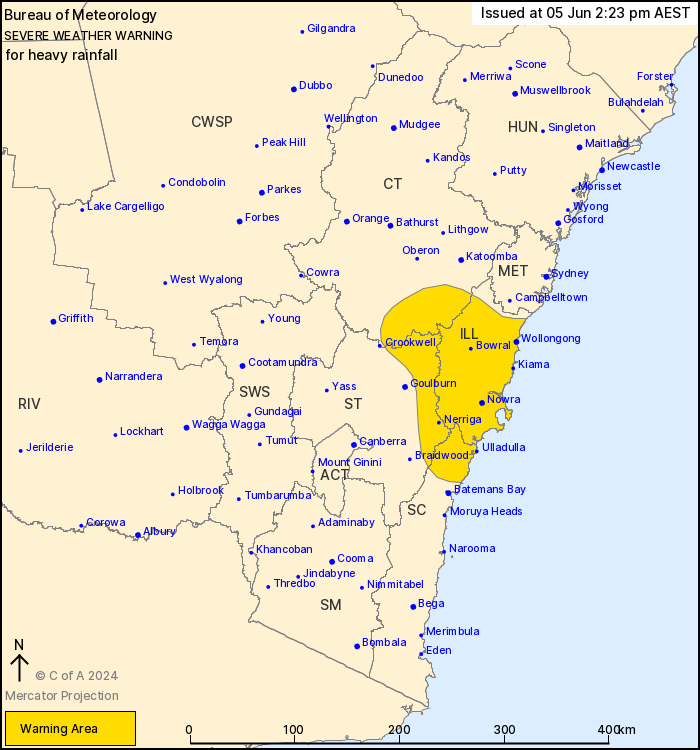Source: Bureau of Meteorology
For people in Illawarra and parts of South Coast, Central
Tablelands and Southern Tablelands Forecast Districts.
Issued at 2:23 pm Wednesday, 5 June 2024.
Heavy rainfall developing about parts of the Illawarra, South
Coast and Southern and Central Tablelands from early Thursday
morning.
Weather Situation: A surface trough extending from the Illawarra
region into the Tasman Sea will deepen during Thursday in response
to an upper low over New South Wales. A strengthening humid
southeasterly flow to the south of this trough will lead to
persistent rain about the Illawarra, northern parts of the South
Coast and adjacent Southern and Central Tablelands during Thursday
and into Friday.
HEAVY RAINFALL which may lead to FLASH FLOODING is forecast for
parts of the Illawarra, South Coast and Southern and Central
Tablelands districts from Thursday morning. Heavy falls are more
likely in southern parts of the warning area from early morning,
before spreading to northern parts of the area in the afternoon and
evening.
Six-hourly rainfall totals between 50 and 90 mm are likely with
isolated totals of 120 mm possible on the windward ranges.
24-hourly rainfall totals between 100 and 150 mm are likely with
isolated totals of 250 mm possible.
Conditions are expected to ease during Friday morning as the
trough moves south, however there is some uncertainty in the longer
term movement and development of the system.
Various Flood Watch and Warning products are current for this
area. Please refer to http://www.bom.gov.au/nsw/warnings/
Locations which may be affected include Wollongong, Nowra, Bowral,
Ulladulla, Taralga and Nerriga.
The State Emergency Service advises that people should:
* Don't drive, ride or walk through flood water.
* Keep clear of creeks and storm drains.
* If you are trapped by flash flooding, seek refuge in the highest
available place and ring 000 if you need rescue.
* Be aware that run-off from rainfall in fire affected areas may
behave differently and be more rapid. It may also contain debris
such as ash, soil, trees and rocks.
* After bushfires, heavy rain and the loss of foliage can make the
ground soft and heavy, leading to a greater chance of
landslides.
* Stay vigilant and monitor conditions. Note that the landscape
may have changed following bushfires.
* For emergency help in floods and storms, ring your local SES
Unit on 132 500.

05/Jun/2024 04:29 AM



